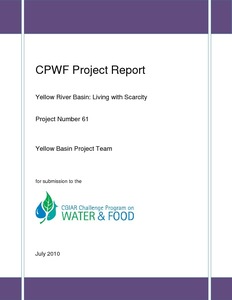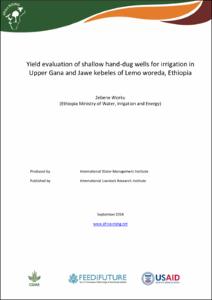Yellow River Basin: Living with scarcity
The Yellow River Basin (YRB) Focal Project set out to study water poverty, water
availability and access, water productivity, and water and related institutions in the
Yellow River basin to develop and rank a series of high-priority interventions aimed at
increasing water and food security for the poor, while maintaining environmental
sustainability. The YBFP identified complex relations between water and poverty in the
YRB; identified streamflow declines in the basin despite predicted higher rainfall;
Yield and water use efficiency of furrow irrigated potato under regulated deficit irrigation, Atsibi-Wemberta, North Ethiopia
The pressure on availability of water in Tigray regional state is likely to increase as the requirement for food production in couple with rapidly growing of the population is at increasing rate. Hence, improving water productivity using regulated deficit irrigation is important to reduce the water consumption while minimizing adverse effects on the crop yield. This study was conducted in the eastern zone of Tigray regional state, Atsibi Womberta district.
Yield evaluation of shallow hand-dug wells for irrigation in Upper Gana and Jawe kebeles of Lemo woreda, Ethiopia
Yield gaps in oil palm: A quantitative review of contributing factors
Oil palm, currently the world’s main vegetable oil crop, is characterised by a large productivity and a long life span (?25 years). Peak oil yields of 12 t ha?1 yr?1 have been achieved in small plantations, and maximum theoretical yields as calculated with simulation models are 18.5 t oil ha?1 yr?1, yet average productivity worldwide has stagnated around 3 t oil ha?1 yr?1. Considering the threat of expansion into valuable rainforests, it is important that the factors underlying these existing yield gaps are understood and, where feasible, addressed.
The rising challenge of water resources management at the urban fringes - evidence from Ferghana district of Uzbekistan [Abstract only]
With the global expansion of urban areas, competition over both land and water resources is steadily increasing, especially within developing countries(FAO 2012; Kuslu 2007; CER 2009). The expansion of urban areas into agricultural areas, such as in Uzbekistan, has created competition for water between farmers and non-farmers (FAO 2002, 2005). Subsequent growth of urban and peri-urban areas envisages new and expanded demands for water resources, entailing both reproductive and productive uses especially by the poor (Drechsel et al. 2006; van Koppen et al. 2006).
Investir dans la gestion de l eau en agriculture au profit des petits exploitants agricoles du Burkina Faso.
This Working Paper summarizes research conducted as part of the AgWater Solutions Project in Burkina Faso between 2009 and 2012. Researchers from the AgWater Solutions Project examined the potential for small reservoirs, inland valley cultivation and the use of motorized pumps. The main findings indicate that (1) Small reservoirs need better management at all stages to reduce costs and improve equity.Costs could be comparable with other AWM options. The total investment to reach 50% of the potential demand in Burkina Faso could be as much as USD 1,136 million.
Sistematización del proceso de construcción y redacción del marco conceptual Mecanismos para Compartir Beneficios derivados de la Gestión del Agua en Cuencas de la Región Andina
Water security amongst impoverished households in the Sundays river valley municipality: community experiences and perspectives
Water security is influenced by the complex interplay between ecological, socio-political, governance and water management systems. Achieving water security is essential for ensuring sustainable development, and challenges with water security are closely linked to the overall experience of poverty that many countries throughout the world, including South Africa, confront. These problems can broadly be understood through three main factors: water availability, access and usage; water governance and management underpin these factors.
Water for Livestock
The first phase of the “Water for Livestock in Isiolo and Garissa Counties, Kenya — Enhancing water resource and rangeland management community capacity through training and strategic water development” has been implemented in in the arid and semi-arid lands of Kenya by IUCN, the Kenya Red Cross Society, and Adeso, with the support from the Swiss Agency for Development and Cooperation. The overall objective of the pilot phase of the project was to improve livelihoods and resilience against drought for targeted communities in North Eastern Kenya.






